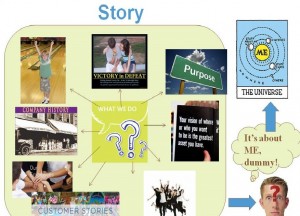Every buyer has a story about his or her work, what’s wrong, what’s right and why he or she does what they do. Conversely, every company has a story they tell buyers about why they should buy. Sometimes, those stories don’t match. That’s an issue. Do you know the buyer story in every situation? You should.
Here’s the thing – every buyer has a story that drives their decision-making. If your story about the way the world works doesn’t fit your buyer’s view, forget getting easy traction.
Now sometimes companies have disruptive stories and that may take time to persuade your audience that newer is better. It certainly happens. When you can paint a picture of what could be, and how that can change your buyer’s world, that’s where you start.
The challenge is buyers aren’t looking to be disrupted and to have their status quo shifted unless the status quo is broken, and they know it and feel it. Then, they are emotionally invested in a solution. This is why understanding the story your buyer believes about the status quo is critical.
The Buyer Story: A Solution Without a Problem isn’t a Solution
Recently, I sat with a company on a few strategy discussions. The company is positioning themselves as a better alternative to budgeting and forecasting with excel. While the users are steeped in excel, the buyers who are higher level finance and accounting executives are not. They are not doing the heavy excel work often. And many of the users don’t see the status quo as unsustainable. When buyers and users aren’t feeling a tremendous pain your company aims to solve, your story needs work.
I asked the company, then, how their positioning was working. Their response wasn’t surprising: not as well as it could be. Here’s the point: in the minds of many of the buyers, excel is not broken. So what problem, then, is your solution really solving for buyers? They don’t know they’re ‘supposed’ to have an excel problem! To the buyer, then, your solution…well, actually isn’t one. Your story, then, is focused on the wrong challenge.
That disconnect can make a big difference.
My friend and colleague, Michael Margolis, says (I’m paraphrasing) when you get the revelation up on the mountain about a better way to do things and you come back to the village excited to share your new wisdom, you have to remember: the people in the village never left.
They didn’t get the memo that things are broken. That’s a barrier you have to address.
Buyer Story Alignment: Crossing the Story Chasm
So what do you do? There are a few things to consider to bring the buyer story into alignment with your product and company stories:
1. Paint a picture of what could be in a nonjudgmental way. It’s challenging because it can take time; however, helping people see what could be means using patience and planting seeds, not using a hammer. What could be if they made the switch? How would life be better? It may not fit in the buyer’s current narrative; however, stories based on results (no fear, no judgment) can persuade over time. This is a great path for disruptive technologies, for example, if it can be told in a way that makes customers’ lives better. That means you need to understand where the customer pain actually is and it may not be what you think.
2. Understand the potential risk and address it directly. Buyers and those who recommend services (and influence the buy) feel risk when something new is introduced. It’s human behavior. Tell the story of how you can reduce risk. Also address the buyer’s risk of continuing on the ‘status quo’ path. You can’t avoid this discussion. Go into the cave!
3. Tell the story of how you can make the buyer look good personally. Human beings make purchases, not businesses. When you can address the personal aspect of your services in addition to rational company value (and in b2b the research shows the personal value is 2X as important in the decision to buy!), you can cross the story chasm. That personal value must be in alignment with what buyers actually value personally. Ask, do your research, and listen.
By listening and adjusting, your stories will be better for it. And so will your business.
How do you better understand your buyer’s “story?” How do you achieve alignment?
Kathy’s new ebook is on Amazon now: Marketing Executive’s Bedtime Guide to Better Content Through Storytelling and Humor



